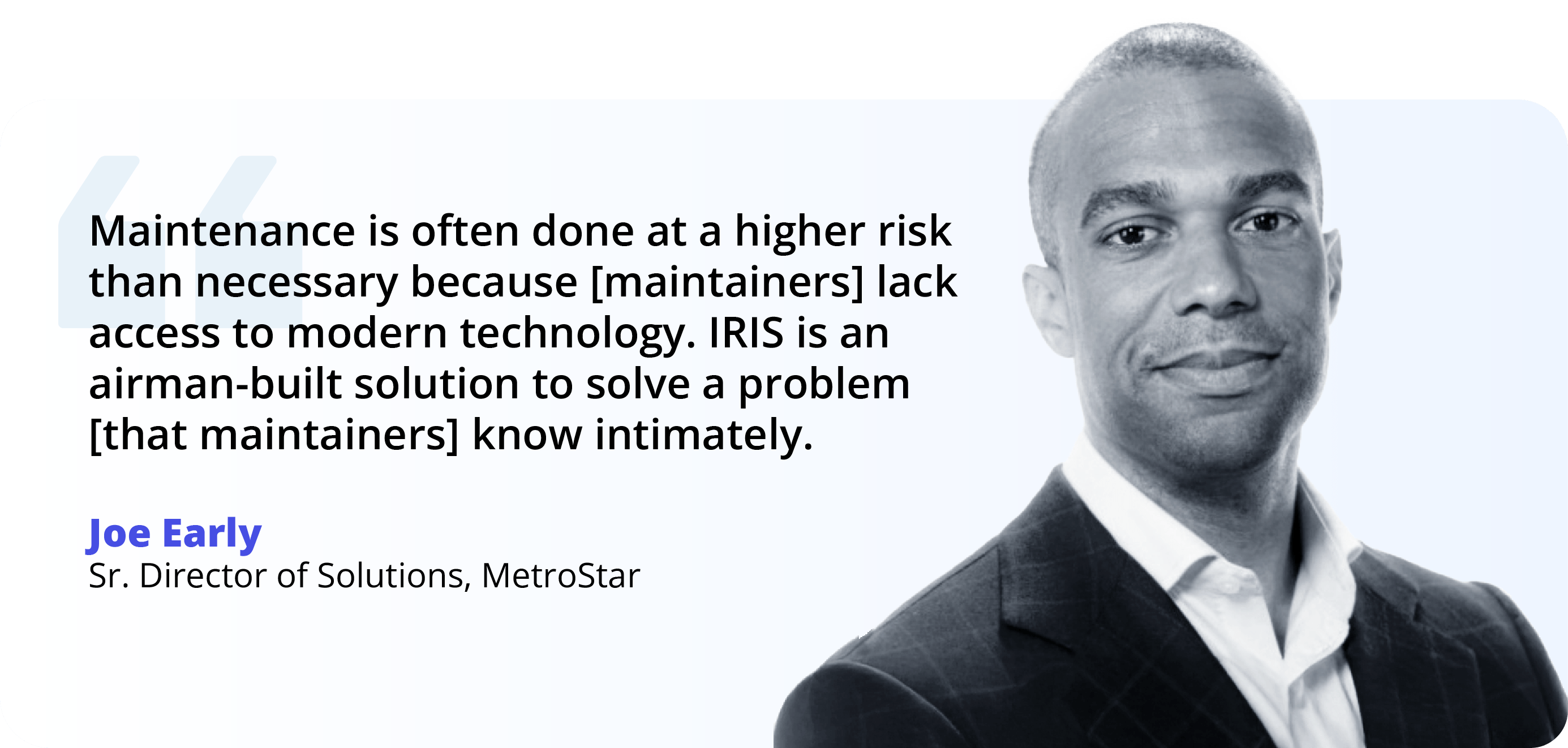Integrated Respirator Information System (IRIS)
A Certified, AI-Enabled Wearable for Confined-Space Aircraft Maintenance
Warfighter-Built. Team MetroStar-Engineered. A Safer, Smarter Way to Perform Aircraft Maintenance in Hazardous Environments.
PHOTO BY: AIRMAN 1ST CLASS AIDAN MARTINEZ
Case Study
A Warfighter-Driven Wearable System Redefining Confined-Space Maintenance
Confined-space maintenance on aging aircraft platforms like the KC-135 has long challenged safety, efficiency, and mission readiness. The IRIS (Integrated Respirator Information System) solution—born from airmen insights and realized through a MetroStar and ActionStreamer partnership—represents a leap forward in digital sustainment for hazardous operational environments.
IRIS equips maintainers with a UL-certified intrinsically safe, AI-enabled, hands-free wearable system that provides real-time video, audio, and lighting. The solution connects directly to a mobile workstation and remote analysts, enabling streamlined inspections, expert support, and future integration with advanced computer vision analytics.
Designed to meet strict DoD safety certifications, and future-proofed with AI integration, IRIS unlocks a new class of data-informed maintenance across Defense, aerospace, and hazardous industrial domains.
The figures below represent projected benefits validated through prototype testing and user interviews. With field deployment underway at Royal Air Force (RAF) Mildenhall, real-world performance data will soon confirm the scale of impact across U.S. Air Force sustainment operations.
60% Faster
Confined-Space Inspections
35,000 Maintenance Hours
Projected Saved Per Year Across a KC-F135 Fleet
7,000+ Additional
Aircraft-Availability Days Annually
Case Study
A Warfighter-Driven Wearable System Redefining Confined-Space Maintenance
Confined-space maintenance on aging aircraft platforms like the KC-135 has long challenged safety, efficiency, and mission readiness. The IRIS (Integrated Respirator Information System) solution—born from airmen insights and realized through a MetroStar and ActionStreamer partnership—represents a leap forward in digital sustainment for hazardous operational environments.
IRIS equips maintainers with a UL-certified intrinsically safe, AI-enabled, hands-free wearable system that provides real-time video, audio, and lighting. The solution connects directly to a mobile workstation and remote analysts, enabling streamlined inspections, expert support, and future integration with advanced computer vision analytics.
Designed to meet strict DoD safety certifications, and future-proofed with AI integration, IRIS unlocks a new class of data-informed maintenance across Defense, aerospace, and hazardous industrial domains.
The figures below represent projected benefits validated through prototype testing and user interviews. With field deployment underway at Royal Air Force (RAF) Mildenhall, real-world performance data will soon confirm the scale of impact across U.S. Air Force sustainment operations.
60% Faster Confined-Space Inspections
35,000 Maintenance Hours Projected Saved Per Year Across a KC-F135 Fleet
7,000+ Additional Aircraft-Availability Days Annually
The Agency +Scale
IRIS began by addressing a critical pain point for the Air Force’s sustainment community: how to modernize inspection workflows for legacy airframes without compromising safety in hazardous, confined environments.
This operational backdrop made RAF Mildenhall an ideal launch point for a mission-ready, intrinsically safe wearable solution like IRIS. With fuel-cell inspections required at regular intervals and legacy platforms nearing end-of-life cycles, the need for a faster, safer inspection capability was acute.
Agency: U.S. Air Forces Europe (USAFE), Maintenance and Sustainment Command
Pilot Site: RAF Mildenhall, supporting global tanker and mobility operations
Mission: Sustain flight readiness and operational safety through timely, accurate aircraft inspections
Scope: Confined-space environments (e.g., fuel tanks) on aging platforms like the KC-135
Pre-IRIS Conditions: No digital visibility, paper-based logs, and communication via shouting, banging, and tugging air lines
The Agency +Scale
IRIS began by addressing a critical pain point for the Air Force’s sustainment community: how to modernize inspection workflows for legacy airframes without compromising safety in hazardous, confined environments.
This operational backdrop made RAF Mildenhall an ideal launch point for a mission-ready, intrinsically safe wearable solution like IRIS. With fuel-cell inspections required at regular intervals and legacy platforms nearing end-of-life cycles, the need for a faster, safer inspection capability was acute.
Agency: U.S. Air Forces Europe (USAFE), Maintenance and Sustainment Command
Pilot Site: RAF Mildenhall, supporting global tanker and mobility operations
Mission: Sustain flight readiness and operational safety through timely, accurate aircraft inspections
Scope: Confined-space environments (e.g., fuel tanks) on aging platforms like the KC-135
Pre-IRIS Conditions: No digital visibility, paper-based logs, and communication via shouting, banging, and tugging air lines

MetroStar Approach
Human-Centered Engineering for a Mission-Critical, AI-Enabled Wearable System
IRIS started as a problem observed firsthand by maintainers and championed through innovation pipelines like AFWERX. MetroStar’s approach connected warfighter insights, safety engineering, and AI integration to deliver a certified solution ready for mission deployment.
MetroStar Approach
Human-Centered Engineering for a Mission-Critical, AI-Enabled Wearable System
IRIS started as a problem observed firsthand by maintainers and championed through innovation pipelines like AFWERX. MetroStar’s approach connected warfighter insights, safety engineering, and AI integration to deliver a certified solution ready for mission deployment.
Certified Wearable Architecture + Data-Driven
Inspection Platform
Designed in direct response to warfighter needs, IRIS’s form factor, safety architecture, and real-time data capabilities deliver immediate and long-term intelligence value.
Results + Impact
Measurable Gains in Safety, Speed, & Sustainment
As IRIS begins field deployment across U.S. Air Force maintenance units, early metrics and user feedback are confirming what initial testing projected: this warfighter-built solution directly improves aircraft availability, inspection speed, and operational safety in high-risk environments.
Results + Impact
Measurable Gains in Safety, Speed, & Sustainment
As IRIS begins field deployment across U.S. Air Force maintenance units, early metrics and user feedback are confirming what initial testing projected: this warfighter-built solution directly improves aircraft availability, inspection speed, and operational safety in high-risk environments.


